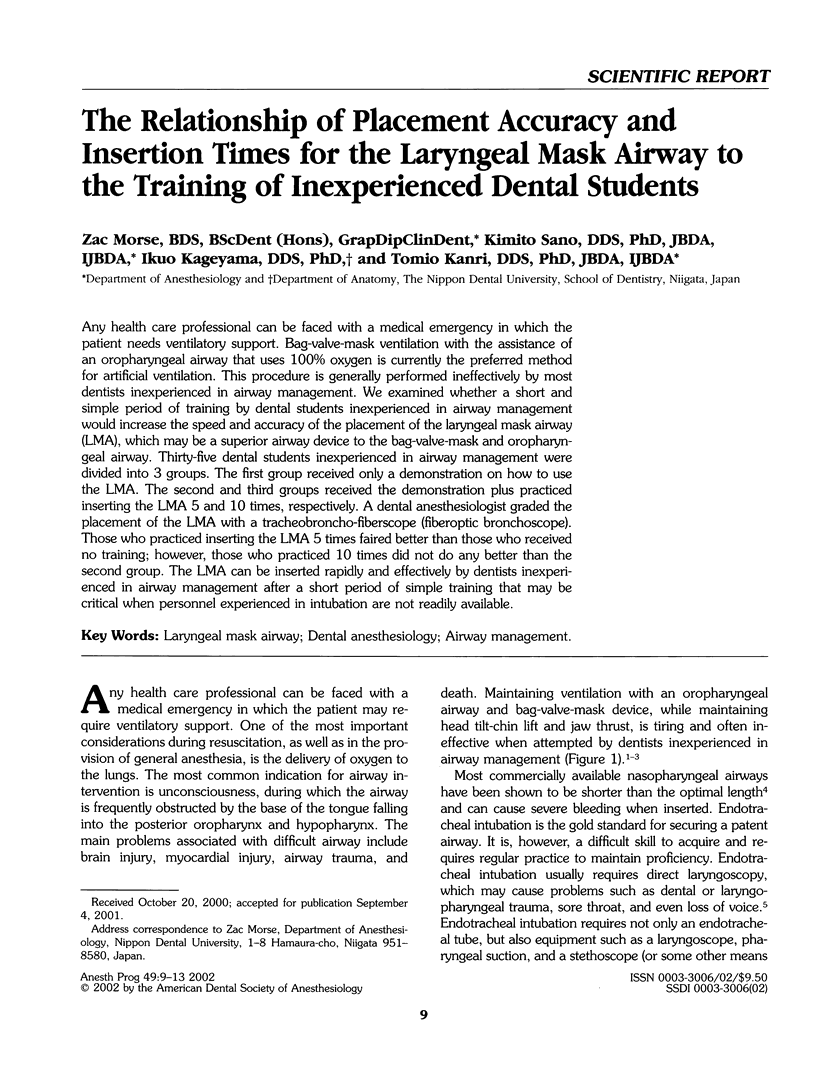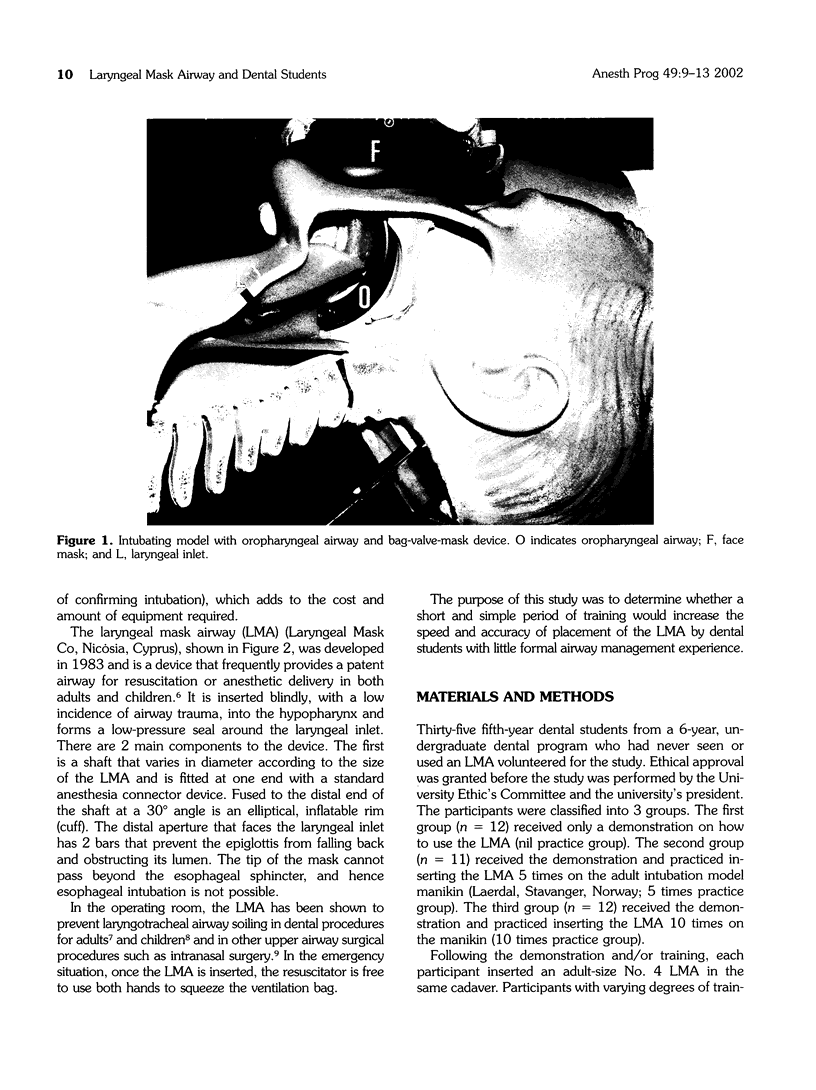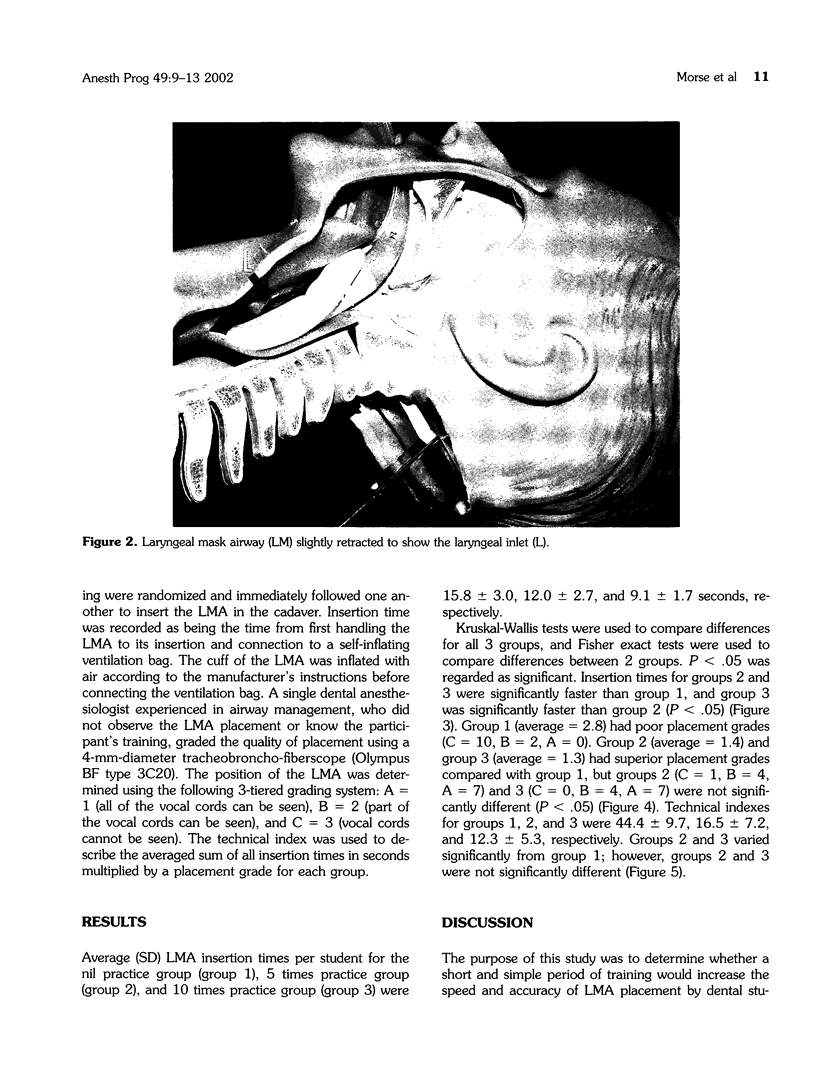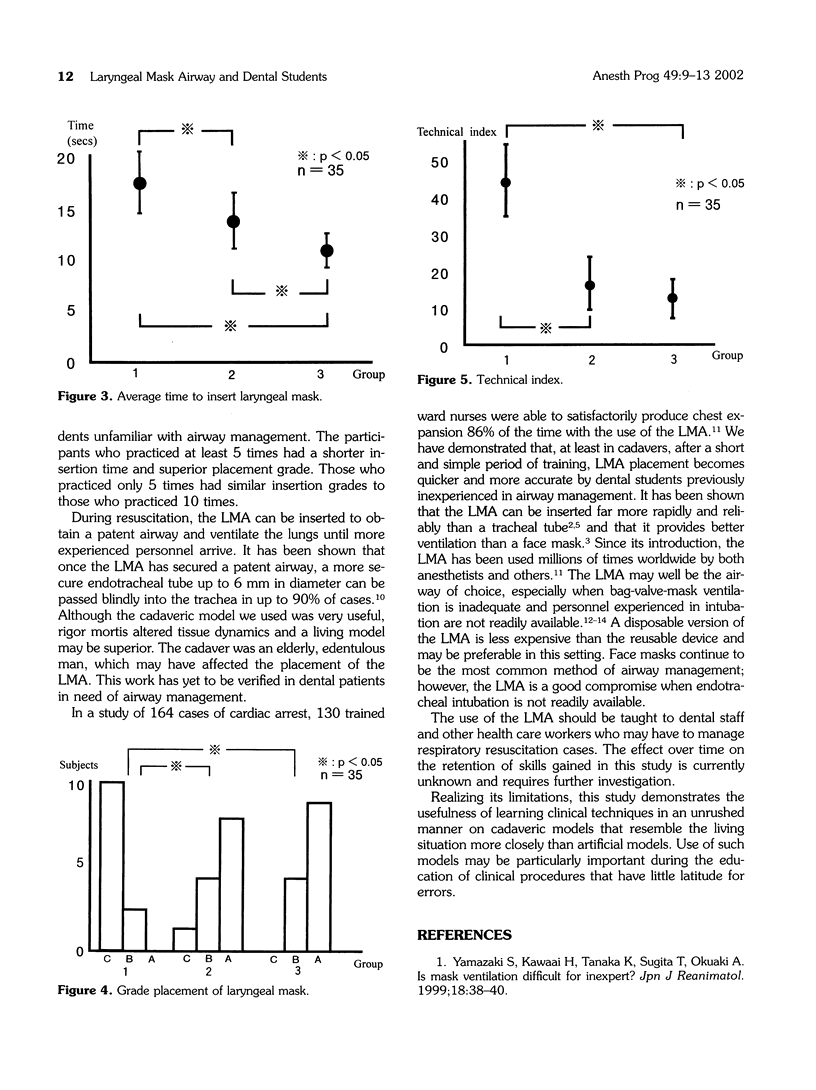Abstract
Any health care professional can be faced with a medical emergency in which the patient needs ventilatory support. Bag-valve-mask ventilation with the assistance of an oropharyngeal airway that uses 100% oxygen is currently the preferred method for artificial ventilation. This procedure is generally performed ineffectively by most dentists inexperienced in airway management. We examined whether a short and simple period of training by dental students inexperienced in airway management would increase the speed and accuracy of the placement of the laryngeal mask airway (LMA), which may be a superior airway device to the bag-valve-mask and oropharyngeal airway. Thirty-five dental students inexperienced in airway management were divided into 3 groups. The first group received only a demonstration on how to use the LMA. The second and third groups received the demonstration plus practiced inserting the LMA 5 and 10 times, respectively. A dental anesthesiologist graded the placement of the LMA with a tracheobroncho-fiberscope (fiberoptic bronchoscope). Those who practiced inserting the LMA 5 times faired better than those who received no training; however, those who practiced 10 times did not do any better than the second group. The LMA can be inserted rapidly and effectively by dentists inexperienced in airway management after a short period of simple training that may be critical when personnel experienced in intubation are not readily available.
Full text
PDF




Images in this article
Selected References
These references are in PubMed. This may not be the complete list of references from this article.
- Alexander R., Hodgson P., Lomax D., Bullen C. A comparison of the laryngeal mask airway and Guedel airway, bag and facemask for manual ventilation following formal training. Anaesthesia. 1993 Mar;48(3):231–234. doi: 10.1111/j.1365-2044.1993.tb06909.x. [DOI] [PubMed] [Google Scholar]
- Davies P. R., Tighe S. Q., Greenslade G. L., Evans G. H. Laryngeal mask airway and tracheal tube insertion by unskilled personnel. Lancet. 1990 Oct 20;336(8721):977–979. doi: 10.1016/0140-6736(90)92429-l. [DOI] [PubMed] [Google Scholar]
- George J. M., Sanders G. M. The reinforced laryngeal mask in paediatric outpatient dental surgery. Anaesthesia. 1999 Jun;54(6):546–551. doi: 10.1046/j.1365-2044.1999.00851.x. [DOI] [PubMed] [Google Scholar]
- Heath M. L., Allagain J. Intubation through the laryngeal mask. A technique for unexpected difficult intubation. Anaesthesia. 1991 Jul;46(7):545–548. doi: 10.1111/j.1365-2044.1991.tb09652.x. [DOI] [PubMed] [Google Scholar]
- Martin P. D., Cyna A. M., Hunter W. A., Henry J., Ramayya G. P. Training nursing staff in airway management for resuscitation. A clinical comparison of the facemask and laryngeal mask. Anaesthesia. 1993 Jan;48(1):33–37. [PubMed] [Google Scholar]
- Oczenski W., Krenn H., Dahaba A. A., Binder M., El-Schahawi-Kienzl I., Kohout S., Schwarz S., Fitzgerald R. D. Complications following the use of the Combitube, tracheal tube and laryngeal mask airway. Anaesthesia. 1999 Dec;54(12):1161–1165. doi: 10.1046/j.1365-2044.1999.01107.x. [DOI] [PubMed] [Google Scholar]
- Pennant J. H., Walker M. B. Comparison of the endotracheal tube and laryngeal mask in airway management by paramedical personnel. Anesth Analg. 1992 Apr;74(4):531–534. doi: 10.1213/00000539-199204000-00011. [DOI] [PubMed] [Google Scholar]
- Quinn A. C., Samaan A., McAteer E. M., Moss E., Vucevic M. The reinforced laryngeal mask airway for dento-alveolar surgery. Br J Anaesth. 1996 Aug;77(2):185–188. doi: 10.1093/bja/77.2.185. [DOI] [PubMed] [Google Scholar]
- Reinhart D. J., Simmons G. Comparison of placement of the laryngeal mask airway with endotracheal tube by paramedics and respiratory therapists. Ann Emerg Med. 1994 Aug;24(2):260–263. doi: 10.1016/s0196-0644(94)70139-3. [DOI] [PubMed] [Google Scholar]
- Watanabe K., Kihara M., Miura M., Nishiyama J., Katoh H., Takiguchi M. [Optimal length of nasopharyngeal airway and its correlation with height and body weight]. Masui. 1999 Apr;48(4):368–371. [PubMed] [Google Scholar]
- Webster A. C., Morley-Forster P. K., Janzen V., Watson J., Dain S. L., Taves D., Dantzer D. Anesthesia for intranasal surgery: a comparison between tracheal intubation and the flexible reinforced laryngeal mask airway. Anesth Analg. 1999 Feb;88(2):421–425. doi: 10.1097/00000539-199902000-00037. [DOI] [PubMed] [Google Scholar]




